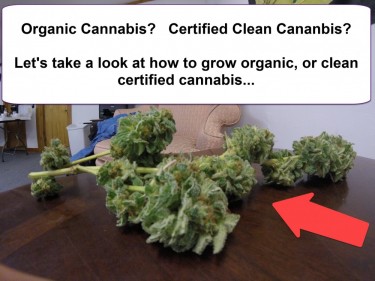
What exactly is clean green certified cannabis?
Due to federal laws that currently do not recognize marijuana as an “agricultural crop”, it cannot be approved as an organic product. This realization means the marijuana industry does not have the right to use USDA organic labeling.
As a result, some companies are starting to take the initiative to make industry-based ethics comparable to those of the USDA. To achieve this goal, the idea of Clean Green was born.
This initiative has been described as the closest initiative to organic. Clean Green is a major qualification program available to marijuana manufacturers and processors across the country. It was also set up to make it easy for customers and cannabis enthusiasts to identify products that adhere to organic principles.
The Clean Green Initiative remains the largest marijuana certification platform in America. This platform has come a long way since 2008, successfully certifying 175 companies and up to 60,000 pounds of marijuana annually. This number doesn’t include tiny buds and trimmings that have been processed as edibles and extracts.
The program is in widespread use in six US states, including Puerto Rico, and will roll out on the East Coast and Canadian markets later this year. What is Clean Green about?
The clean green idea
Founded in 2004, Chris Van Hook launched this platform who previously worked as an attorney and expert on organic certification with USDA accreditation. He was signed to a marijuana farmer in 2003 who wanted to become a licensed organic grower. Chris wanted to certify the farmer, but federal law couldn’t do that.
Instead, Chris created Clean Green as a certification platform and expanded it to include marijuana processors, manufacturers, products and distributors. He claims that the platform is based on the “gold” level for the agri-food sector, the USDA standard.
Chris claims that no one can claim their marijuana is organic (this is a fact of federal law). Still, people can achieve clean green certified status if they follow state organic rules.
The requirements for clean green certification
In order for a product to receive the Clean Green Certified logo, the manufacturer must follow a few rules, including:
To be a Clean Green certified manufacturer, your marijuana product must be made with pre-approved ingredients. These inputs are also permitted within the framework of the organic programs of the federal and state governments: This ensures that consumers receive a good price-performance ratio. The entrances cross:
-
Clones
-
floor
-
nutrient
-
Seeds
-
Pesticides
-
All edible production ingredients
-
Other products used to make extracts, edibles, and plants.
By following the same USDA regulations, the Clean Green Group will adhere to a globally recognized and reliable standard that is maximized in other agricultural areas.
In order to get the Clean Green certification, you must also take the annual intensive exam. During such assessments, inspectors identify marijuana plant health issues such as mites, mold, and other pests that can affect the quality and safety of the final product.
More so, when a cannabis company has Clean Green certification, it is evident that its facilities do not pose any environmental threat to the community.
The inspectors also monitor how the companies are sourcing water and electricity, and whether the facilities are functioning properly in terms of soil erosion, drainage systems, clean water and the general health of the environment. These are critical considerations before marking the inspection process as “Complete”.
Clean Green has made sure that all of its inspectors have the appropriate qualifications and it is compared to the qualification of a County Agricultural Inspector. The inspectors also have a bachelor’s degree in science or agriculture in particular. It is required that they have up to five years of experience in the cannabis industry.
After all, the finished product must also meet all the criteria, regardless of the type of product. From extracts to flowers and edibles, the product must meet Clean Green certification requirements, which include:
-
It must be paired with a tracking number
-
It must be packed properly
-
No entries, pests or molds may be prohibited.
When a cannabis-based product receives the Clean Green label, consumers can rest assured that their purchase is of the highest quality, healthy, clean and well-cared for. Many Cannabis Cup Awards have recognized Clean Green’s exceptional efforts by giving the company multiple awards.
Clean Green has made a clear connection between healthy and good quality marijuana from other non-standard products. Chris said it is a pleasure for the team to stand side by side with marijuana farmers at the end of a growing season to analyze the quality of the marijuana plants.
There is still a lot to be done in this “organic” marijuana field, but Clean Green has already got the ball rolling and set a high standard for subsequent companies, you are sure to find one with the Clean Green seal of approval.
So it’s safe to say that the days of looking for high quality products and not getting them are over. The cannabis industry was completely revolutionized with the Clean Green Agenda. It is intended to offer first-class sustainable and healthy products from farm to shelf.
Bottom line
Clean Green as a company continues to thrive and strive to become the most sought after and trusted platform for those looking for high quality and healthy marijuana products. This is a company built on the founder’s passion for marijuana, offering producers a sustainable agricultural alternative.
The company also wants to establish and support farms and businesses that do everything in their power to ensure that their products are up to standard. The lack of government support for marijuana in America hasn’t completely crippled the industry. Clean Green has created a niche for itself and, with its quota, is helping to boost the American cannabis sector.
ORGANIC OR GREEN CLEAN, READ MORE …

HOW DO YOU GROW CERTIFIED CLEAN CANNABIS? WATCH THIS VIDEO!
OR..

ORGANIC CANNABIS AND THE GROWTH EFFECT ON INDUSTRY?

Post a comment: